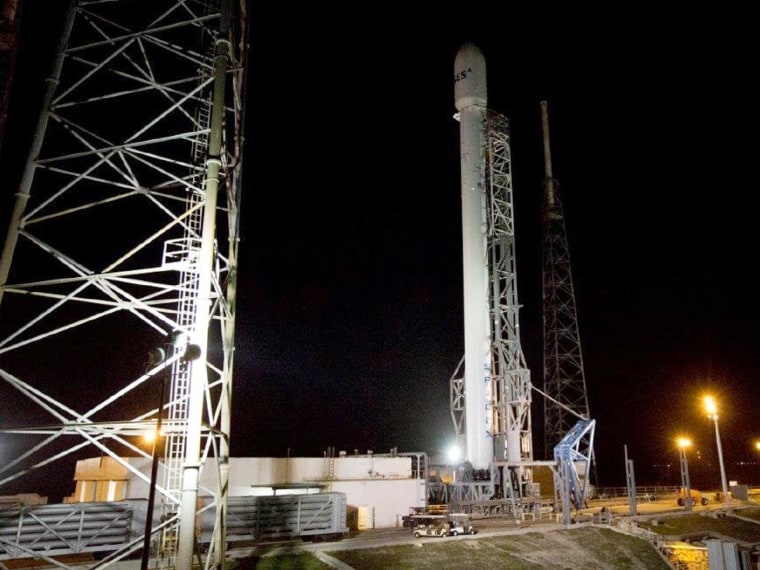The private spaceflight company SpaceX is counting down to a critical commercial satellite launch in Florida on Monday, and you can watch the launch attempt live online.
SpaceX's upgraded Falcon 9 rocket will blast off from a pad at Cape Canaveral Air Force Station at 5:37 p.m. ET carrying the SES-8 satellite into orbit for the communications satellite company SES. The mission will mark several big firsts for SpaceX, including the company's first launch of its upgraded Falcon 9 rocket from Florida, its first launch of a huge commercial satellite and its first flight to the high geostationary transfer orbit needed for most commercial satellites.
SpaceX will begin its launch webcast at 5 p.m. ET. If possible, Space.com will carry SpaceX launch webcast live here. You can also follow it directly on SpaceX's website.
Monday's launch will be the second flight of SpaceX's upgraded Falcon 9 rocket, known as the Falcon 9 Version 1.1. The mission will mark the Falcon 9's entry into the commercial satellite market — a major milestone — after a series of test flights and launches for NASA and the Canadian Space Agency. [A less powerful SpaceX rocket, the Falcon 1, put a Malaysian-built commercial satellite called RazakSat into orbit in 2009.]
"Let me put this very, very clearly," Martin Halliwell, SES chief technology officer, said during a teleconference with reporters on Sunday. "The entry of SpaceX into the commercial market is a game-changer. It's going to really shake the industry to its roots." [See launch photos for SpaceX's improved Falcon 9 rocket]
Halliwell said that SES had an extraordinary level of access to SpaceX's work on the new rocket, which gave his company the confidence to fly their 3.2-ton satellite on the Falcon 9.
Big business in space
Founded in 2002, the Hawthorne, Calif.-based SpaceX (the name is short for Space Exploration Technologies) already has a $1.6 billion deal with NASA to launch at least 12 commercial cargo missions to the International Space Station using its Falcon 9 rockets and Dragon space capsules. Two of those missions have been flown, with the third slated to fly in February. The company is also competing to launch manned versions of Dragon capsules to ferry NASA astronaut crews to and from the space station. [6 Fun Facts About SpaceX]
On Sept. 29, SpaceX launched its first Falcon 9 v1.1 from the company's pad at Vandenberg Air Force Station in California, sending the Cassiope space weather monitoring satellite into orbit for the Canadian Space Agency. That mission successfully placed the satellite in its intended orbit, but a test of the rocket's second stage restart capability — a necessity for today's launch — failed due to a frozen igniter fluid line. SpaceX has added more insulation to the fluid line to prevent the glitch from occurring again.
"We've done everything we can think of to maximize the reliability of this launch system," SpaceX's billionaire founder Elon Musk told reporters Sunday. "We're really happy with this rocket design, and it's an incredibly capable vehicle."
The two-stage Falcon 9 rocket is a 224.4 feet (68.4 meters) booster designed to launch SpaceX's Dragon space capsule and satellites into orbit. The rocket made its launch debut in 2010 and has flown six missions to date. SpaceX says it was named after the Millennium Falcon from the "Star Wars" science fiction films, with SpaceX's Dragon capsules named for the fictional Puff the Magic Dragon.
SpaceX advertises standard Falcon 9 rocket launches at a price of $56.7 million. It is designed to be more affordable and reliable than other commercial rocket launch vehicles available today, Musk said.
"I believe its inherent reliability potential is better than any other rocket in the world," Musk said. "And it is up to us to live up to that potential."
Built to be reusable
The Falcon 9 v1.1 rocket's first stage is powered by nine Merlin 1D engines (also built by SpaceX) arranged in a circular "Octaweb" pattern to enhance engine performance. It is topped with a payload fairing 17 feet (5.1 meters) wide, large enough to fit a bus inside. The upgraded rocket also includes a triple-redundant flight computer and a heat shield to protect its first stage during re-entry as part of SpaceX's reusable rocket project.
Monday's launch will send the 6,918-pound (2,138-kilogram) SES-8 satellite into an orbit that comes within 183 miles (295 kilometers) of Earth at its nearest point and goes out to 49,709 miles (80,000 kilometers) at its highest. The satellite's propulsion system will later circularize that orbit at a geostationary 22,000 miles (36,000 kilometers) in altitude.
The Orbital Sciences Corp.-built satellite is a hybrid Ku-and Ka-band spacecraft designed to provide high-definition telecommunications services to customers across the South Asia and Pacific region.
Russians also have liftoff
SpaceX's Falcon 9 launch is one of two space missions launching into orbit on Monday. A Russian Soyuz rocket lifted off at 3:53 p.m. ET, sending an unmanned Progress 53 cargo ship toward the International Space Station.
The Progress 53 spacecraft is packed with nearly 3 tons of food, fuel and gear for the six astronauts on the International Space Station. The spacecraft will fly within a mile of the space station on Wednesday "to test an upgraded automated rendezvous system," NASA officials said in a statement.
If all goes well, the Progress 53 spacecraft should dock at the space station on Friday at 5:28 p.m. ET.
Visit Space.com for updates on the SpaceX next-generation Falcon 9 rocket launch. SpaceflightNow is also offering updates via its SpaceX Mission Status Center, which will also include a launch webcast.
This report was updated by NBC News. Email Tariq Malik at tmalik@space.com or follow him @tariqjmalik and Google+. Follow us @Spacedotcom, Facebook and Google+. Original article on Space.com.
